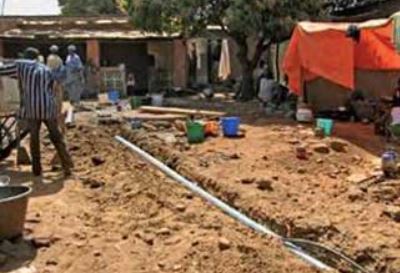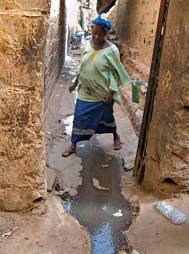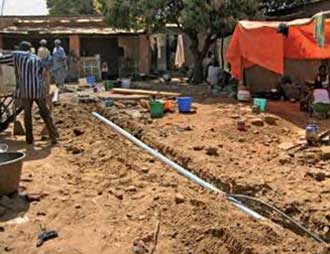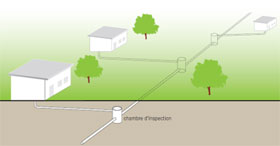



In the absence of means for draining waste water in towns, or shantytowns, a drainage network with a small diameter and low depth connected to all housing units allows for carriage of effluents at a lesser cost than via a conventional type network for a section of town to a larger drainage network or to a decentralised treatment system.
There are two types of mini-networks :
- simplified mini-networks directly collect the grey water and black water (excreta + toilet water) from the housing units
- decanted mini-networks collect only grey or black water which has been pre-treated beforehand at the housing unit level by means of mini-septic tanks and grease traps.
This means has been installed for several decades now in densely inhabited areas where building a conventional type network is either impossible in light of the nature of the location, or is too expensive.
In many shantytowns or poor urban areas, the means for sanitation are insufficient : there are not enough latrines, waste water is thrown directly into the street. There are multiple consequences : contamination of the water tables, development of mosquitoes that transmit diseases, unsanitary conditions…
Draining waste water via mini-networks makes it possible, at a lower cost than with conventional networks thanks to their smaller diameter and to their being buried at a lower depth, to fight these problems.
This means is especially suited for dense urban areas where draining waste water cannot be carried out correctly due to lack of infrastructure. Such a drainage network can be considered on a scale of a community ranging up to about 20,000 inhabitants.
Reminder of the usual method : the conventional network
Most networks, referred to as conventional networks, collect without pre-treatment all of the waste water (grey and black) for substantial populations and are equipped with major infrastructures (large-diameter deeply-buried pipes, inspection openings, rainwater collection drains and if necessary, pumping substations).
These are either unitary if they collect both waste water and rainwater, or separate if they carry waste water and rainwater in specific networks.
Principle of mini-networks :
Mini-networks for drainage, whether they are simplified or decanted, are of a lower diameter and are buried at a low depth. They are generally comprised of PVC tubes of about ten cm in diameter (instead of 20 to about a hundred cm for conventional networks). They are buried at a depth that varies from 0.30 to 1.10m (instead of 1.5 to 3 m for conventional networks). A minimum slope of 0.5% (1m height difference for every 200m of travel) is required to that the waste water flows by means of gravity without any problems. Connection points into the main drainage conduit are installed at the lowest points, in order to connect the various drainpipes buried along the streets to the main conduit. Mini-stations for pumping are added if necessary to the network if the latter is of substantial size.
Each housing unit is connected to the network via a connection box and the waste water is added after passing through a screen in order to prevent clogging the network.
Reinforced concrete manholes must be installed at each connection for maintenance.
Particularity with decanted mini-networks
Contrary to simplified mini-networks, they collect only grey domestic water and the liquid portion of the black water (excreta) that is pre-treated at each housing unit by passing through screens and grease traps in order to prevent clogging the mini-network and in septic tanks.

Sizing
A 10cm diameter conduit with a slope of 0.5% can drain the waste water from 200 5-person households on a basis of 80 litres of waste per person and per day. For higher flows, conduits with a higher diameter are required. Take into account during the design phase that in the event of heavy rain, water can infiltrate into the drainage network, which creates an overload.
Maintenance
The connection manholes must be checked every month if they are located at intersecting or deviation points and every three months everywhere else. It is advisable to check the equipment in the housing units every 1 or 2 months. If a pipe is obstructed, it has to be unclogged, for example using a rigid cable made to enter via a manhole. The water outlet for the entire network has to be verified every two days.

Connecting to a decentralised treatment facility
The benefits derived from a drainage network will be less if the waste water is discharged further on into the environment without treatment. The water collected must ideally be carried to a decentralised treatment facility. If the height difference is not enough, a pump may be required. You can refer to fact sheet A 17 "Various ecological treatment solutions for collective sanitation. General presentation" to consult the various ways to treat water at least cost before discharging it into the environment or reusing it for irrigation.
- Substantial reduction in unsanitary conditions.
- Small footprint on the ground.
- The materials required are usually easy to find
- Creation of jobs for the construction and maintenance, but also possibility for substantial participation, and often benevolently, of the population to create the trenches.
- Rather high investment cost.
- Expertise is required for the design and maintenance
- Clogging occurs more frequently than in a conventional drainage network
This is rather substantial but is 2 to 3 times less than that for a conventional network.
Cost of the investment :
This obviously depends on the region, local price for materials and the degree of participation of the population in the works, but is about €150 to €400 /housing unit (instead of €400 to €900 for a conventional network
Operating and maintenance costs
This is about €10 to €25 /housing unit/year (instead of €20 to €45 /housing unit for a conventional network).
It should be made sure before initiating works that there is no low-depth water table on the planned path for the mini-network, as leaks from the network are always possible and could contaminate it.
CREPA (Regional centre for drinking water and sanitation at low cost) between 2001 and 2004 carried out an action in a lagoon section of Lomé in Togo with the objective if creating a low-diameter drainage network.
The adjoining water table (0.5 to 2m in depth) was contaminated by the latrines and direct discharge of waste water.
A drainage network made it possible to drain the waste water from 125 households. The costs for connecting to the network were set in a consensual manner at 1500 FCFA (about €2.20) per month. Four permanent jobs were created in order to maintain the network.
A stabilization pond 1.3m deep for a surface area of 20m² was created to receive the waste water and decant it in order to ensure summary treatment before discharging it into the natural environment, at a location that was not a threat to the groundwater.
- Brochure "Ensure sanitation for all" edited by Arene, PS-eau and SIAAP, interesting general documentation on the main sanitation devices
Available online on : www.pseau.org
- Healthy management of household waste water, the example of a lagoon section of Lomé in Togo, CREPA
- Manuel for maintaining and monitoring low-diameter drainage networks, CREPA, 18-page manual explaining the type of network tested at the head office of this Centre at Ouagadougou and how it is maintained.
Available online on :
- WSSCC (Water Supply and Sanitation Collaborative Council) (Geneva) where access is provided to the "Compendium of sanitation systems and technologies": http://docplayer.fr/35427868-Compendium-des-systemes-et-technologies-d-assainissement-2-e-edition-actualisee.html
- SMC methodological guide (Concerted Municipal Strategies), from PDM and PSEau : "Choosing suitable technical solutions for liquid sanitation", very interesting 136-page well-documented illustrated guide written by GRET of which pages 102 to 107 address the subject of drainage networks.
This guide can be requested from PSEau : www.pseau.org
- VIDEO from Waterchannel and CREPA : "Sanitation test projects".
This interesting 25‘ video shows the main experiences of CREPA (Centre for research and action in Ouagadougou-Burkina Faso) in terms of sanitation and more particularly ECOSAN latrines, and low-diameter drainage networks at the end of the video.
Available online at : www.thewaterchannel.tv/index...